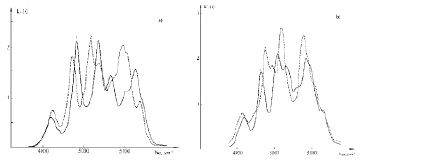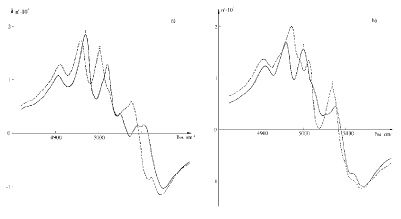Rare earth (RE) iron garnets with narrow ferromagnetic resonance linewidths, very low hysteresis losses, and excellent dielectric properties have been widely applied in microwave devices in a wide range of frequencies (1–100 GHz), magnetooptical transducers and typically employed as magnetic recording media [1-20]. The general chemical structural formula for rare-earth iron garnets (REIG) can be written as RE3Fe2Fe3O12, with eight of these formula units per unit cell. With the overall symmetry being cubic, the space group of REIG is 
 in which three special positions are occupied by magnetic ions. The garnet in fact does not allow distortion to lower symmetry owing to its non-efficiently packed structure, which makes the iron garnet structure unstable with increasing rare earth ionic radius.
in which three special positions are occupied by magnetic ions. The garnet in fact does not allow distortion to lower symmetry owing to its non-efficiently packed structure, which makes the iron garnet structure unstable with increasing rare earth ionic radius.
We studied the crystal-optics properties of europium IG in the regions of the absorption bands of the rare-earth ion. Close attention was paid to the observation of those crystal-optics anisotropy features, which are connected with the change of the relative orientation of the magnetization vector I and the light wave vector. The investigation of the crystal-optics properties of europium IG in the region of the 7F0 – 7F6 absorption band of the rare earth ion Eu3+ has shown [10] that when the light propagates perpendicular to the magnetization (Voight geometry,  ) the crystal is optically uniaxial.
) the crystal is optically uniaxial.
2. Experiment
Using the method of flux growth under 10 bar of oxygen pressure, single crystals of Eu3Fe5O12 were synthesized by B.V. Mill at Moscow State University. X-ray diffraction measurements were in agreement with the garnet  structure. Polished platelets – 100-250 mm thick-oriented perpendicular to the [110] and [100] axes were obtained from the same «as grown» crystal. Magneto-optical measurements were performed at a temperature of 82K and 295K under a magnetic field of up to 25 kOe on the spectrometer facility, characterized in [2, 3, 6]. MLB spectra were obtained in energy region and 4900-5100 cm-1 with a high optical resolution 0.12 cm-1 with the help of a modulation technique. The experimental accuracy is estimated at
structure. Polished platelets – 100-250 mm thick-oriented perpendicular to the [110] and [100] axes were obtained from the same «as grown» crystal. Magneto-optical measurements were performed at a temperature of 82K and 295K under a magnetic field of up to 25 kOe on the spectrometer facility, characterized in [2, 3, 6]. MLB spectra were obtained in energy region and 4900-5100 cm-1 with a high optical resolution 0.12 cm-1 with the help of a modulation technique. The experimental accuracy is estimated at  . It is noted that the samples are cooled at the lowest temperature in the absence of a magnetic field prior to MLB measurements. The angle of rotation of the samples was measured with 0.1º accuracy.
. It is noted that the samples are cooled at the lowest temperature in the absence of a magnetic field prior to MLB measurements. The angle of rotation of the samples was measured with 0.1º accuracy.
3. Results
The dependence of the intensity I(w) of the light transmitted through the sample, as well as of the intensity I0(w) of the light without the sample, was registered with an automatic recorder.
Fig. 1 shows the measured absorption coefficient  , in the Voight geometry, of an Eu3Fe5012 plate cut in the (110) plane, at
, in the Voight geometry, of an Eu3Fe5012 plate cut in the (110) plane, at  ,
,  , Fig. 2 shows the
, Fig. 2 shows the  spectra calculated on these results with the help of the Kramers-Kronig relations (n’ is the contribution made to the refractive index by the light absorption by the RE ions).
spectra calculated on these results with the help of the Kramers-Kronig relations (n’ is the contribution made to the refractive index by the light absorption by the RE ions).
The difference between  and
and  at two E orientations proves that the crystal is optically biaxial. This difference in k’ is a maximum at the frequency of 5450 and 5500 cm-1. It reaches 60 – 70 per cent.
at two E orientations proves that the crystal is optically biaxial. This difference in k’ is a maximum at the frequency of 5450 and 5500 cm-1. It reaches 60 – 70 per cent.
As one can see in Fig. 2 Dn=n’100-n’110 reaches the value of 1x10-3 and reverses sign several times in the region of the absorption band.
Thus the character of the optical anisotropy of the crystal depends on the relative orientation of the vectors k and I. No such effect had been observed before for Eu3Fe5O12 in such geometry of the experiment to our knowledge.
Investigations of the MBL have shown that the anisotropy of the optical properties of an IG magnetized far from the absorption lines can be satisfactorily described with the aid of a dielectric tensor expanded in powers of the magnetization I. In general case a cubic crystal becomes optically biaxial upon magnetization, and the angle between the optical axes is determined by the orientation of the vector I in the crystal, namely, if I is directed along axes such as [111] and [100] the crystal is uniaxial, and in other directions of I it is in general biaxial.

Fig. 1. Absorption spectra of EuIG: a – 1 –  ,
,  ,
,  , 2 –
, 2 –  ,
,  ,
,  ; b – 1 –
; b – 1 –  ,
,  , 2 –
, 2 –  ,
, 

Fig. 2. Frequency dependences of the contribution made to the refractive index by the optical transition 7F0 – 7F6 of the Eu3+ ion of the EuIG: a – 1 –  ,
,  ,
,  , 2 –
, 2 –  ,
,  ; b – 1 –
; b – 1 –  ,
,  ; 2 –
; 2 –  ,
, 
The work is executed at support of the Ministry of education and science of the Russian Federation (the project № 2.2527.2011). Investigations were carried out on the equipment of Natural Sciences Research and Education Centre at North-Ossetian State University.
Библиографическая ссылка
Khubaev A.K., Pashkov A.D., Tsidaeva N.I., Abaeva V.V., Turiev A.M., Enaldieva E.V., Butkhuzi T.G., Khaimanov S.A., Ramonova A.G. ANISOTROPY OF THE LINEAR MAGNETIC BIREFRIDENCE OF EUROPIUM IRON GARNET // Современные наукоемкие технологии. 2014. № 5-2. С. 131-132;URL: https://top-technologies.ru/ru/article/view?id=34022 (дата обращения: 30.12.2025).



